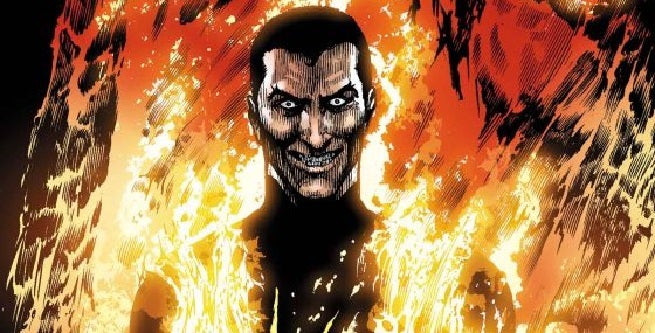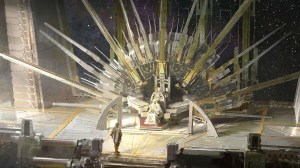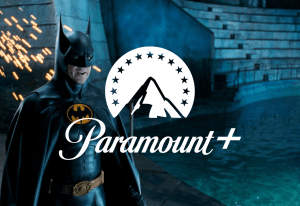
This isn’t the first time that I’ve complained about Moore’s tendency to run off at the mouth with his narration but this might be the worst example out of any issue of Miracleman thus far. It isn’t necessarily that any one of them is bad in and of itself, but the volume of them coupled with the fact that Moore seems completely unable to allow the art to speak for itself is maddening. Moments that should be impactful are unfortunately rendered somewhat sterile and cerebral with his verbose musings overlaid upon them.
Videos by ComicBook.com
Perhaps the worst offender in my opinion is page 19. I hardly feel the need to warn the reader about spoilers for a more-than-26-year-old comic but I will be delving into plot here. Anyway, this comic chronicles the fight between Kid Miracleman and the group of Miracleman, Miraclewoman, the Warpsmiths, and the Firedrake named Huey Moon. While nothing seems able to defeat Kid Miracleman, Warpsmith Aza Chorn ultimately injures him sufficiently to force him to change back into Johnny Bates whereupon Miracleman holds him close before either snapping his neck or crushing his skull, the actual act occurring just off-panel. Page 19 consists of a repeated image of a screaming Miracleman cradling Bates’ lifeless body as the “camera” pulls back. This should be a powerful image, all the more because it is ultimately integrated into a two-page spread on the following page showing the full horror of London’s destruction. However, rather than allowing the art to speak for itself, Moore insists upon meditating on “firemen and the dumbstruck ambulance crews” before inserting the incongruous image of cats let out of the metaphorical bag and worms released from their equally metaphorical can. The saving grace is that the following spread is limited to one short narrative caption completing the worm diversion.
Similarly frustrating, Moore has chosen to make the “Miracleman as god” concept explicitly and literal as opposed to metaphorical. It may be that others may not have the same reaction to this choice but to see Miracleman literally identify himself as the singular god of reality feels a step too far. It isn’t that I balk at what some might perceive as sacrilege. Rather, this feels definitionally incorrect. Going by the nature of a god as being omnipotent, omniscient, and omnipresent, Miracleman does not seem to meet the standard set for existence as a universal deity. I wouldn’t even get into this if Moore didn’t specifically call out omnipotence and omniscience as traits that Miracleman apparently possesses. Honestly, the temptation is too great not to quote The Princess Bride’s, “You keep using that word. I do not think it means what you think it means.” What I mean by this is that obviously Miracleman is not omnipotent or he wouldn’t have needed Aza Chorn to essentially defeat Kid Miracleman for him. As far as omniscience, Miracleman has never demonstrated this trait in any capacity and admits that Kid Miracleman he is unaware of Kid Miracleman’s actions until he chances to glance at a hologram of earth and see the smoke rising from London. As far as omnipresence, being limited to a single physical form existing in the universe in a single location, Moore doesn’t even try to ascribe this trait to Miracleman. Given that the narration is from Miracleman’s perspective and using his voice, it may be that he is simply an unreliable narrator; however, having no reason to think him delusional I cannot help but ascribe this meditation on godhood to an indulgence on Moore’s part.
Another bit of unnecessary pretension which may be more of a sticking point for me than other is the way in which Moore frames the battle with Bates. He says in a narrative caption:
The battle, far too big to be contained by simple facts, has spawned so many different legends, each with its own adherents; as valid, if not more so, as the truth.
He then goes on to describe a number of different scenarios that “might” explain the lead-up to the battle’s ultimate conclusion. This might make sense if the narrator was a third party not privy to the actual events but the narrator is Miracleman himself! For Miracleman (who is the one actually fighting the fight and doing the deeds) to say “In one such theory… True or false, who knows?” is maddening in the extreme because it makes me want to grab him by his baby-blue onesie and shout at him that HE damned well knows and to stop being such a pretentious git. This is compounded by the fact that one of these “theories” was actually presented as a side story early on in the Miracleman saga in such a way as to suggest to the reader that it is in fact the truth. As such, while I’m screaming at Miracleman, I could point out to him that even if he doesn’t recall how things actually occurred, then I certainly do. Don’t get me wrong, I understand what Moore is trying to do here. He is meditating on the nature of myth and the ways in which humans build myths and/or twist facts in order to highlight certain values and ideas. I simply can’t stand it though when in order to accommodate such meditations a writer seems to ignore the established narrative and the concrete reality of the situation.
Honestly, the meat of what happens in this issue is certainly engaging. The problem is that it would be even more so if Moore didn’t feel the need to bog everything down with such a volume of text and spell out the themes he’s playing with rather than suggest them and let the reader chew on them. While he generally isn’t committing the sin of neglecting to “show don’t tell” since his text is attempting to augment the action rather than stand in for it, there is one moment where this in a sense takes place and the story is poorer for it. On page 14, Miracleman throws a car at Bates and the narrative caption states:
My apologists have claimed the car that I first hurled at Bates was empty, those who’d been inside having all previously escaped. I’m sorry, but that isn’t true.
The problem is that its one thing to tell me that there were people in the car but the art gives no indication that this was in fact the case. Intellectually, I know that this is horrible but it doesn’t really hit me on an emotional level in the way it would have if I’d seen the people that were in the car prior to it being thrown.
This actually could be said of most of the destruction in this issue. It’s all so big and impersonal that it loses impact. Intellectually, I know that what I’m seeing is an atrocity but I never connect with anyone Bates murders or mutilates, and thus doesn’t have the same kind of lasting sting. This isn’t helped when Miracleman narrates with the kind of semi-ludicrous terminology like referring to “coral reefs of baby skulls.” Dead babies, regardless of what the internet or infantile bro-y friends might say, are not funny but referring to coral reefs of them is so odd as to take the horror out of the idea. I’m almost tempted to recant my complaint about Johnny Bates’ rape in the last issue as at least that moment impressed the horror of the act upon me.
One last element of the story itself worth noting is the method of Bates’ demise and how it doesn’t quite make sense to me. Ultimately, since no one can really harm him since he is protected by a force field, Aza Chorn teleports a hunk of cement and rebar into his head followed by a girder into his chest. The items appear inside Bates’ force field rather than try to punch through it. Bates is thus caused harm because foreign matter is attempting to occupy the same space as his own, seemingly resulting in a painful displacement or destruction of some sort. My problem is that earlier in the issue, he is teleported almost entirely inside a marble arch, matter attempting to share the same space as other matter. Shouldn’t this have had an even more deleterious effect upon the villain? Why does teleporting small objects inside Bates hurt him when the vast majority of his body being inside a large object does nothing? You can make the argument that Bates teleported inside the marble displaced the marble while items being teleported inside Bates displaced Bates’ body itself. Still, this feels like splitting hairs and perhaps Moore would have been well-advised to not confuse the issue by having Aza Chorn teleport him inside a solid marble structure at all.
A final head-scratching moment barely worth noting is when the narration says, “Having exhausted all the humdrum cruelties known to man quite early in the afternoon, [Kid Miracleman] had progressed to innovations unmistakably his own.” When this narrative text appears, Bates seems to be holding a human arm with what looks like a few bites taken out of it and blood running down his face. I hate to break it to Bates and Moore but neither of them invented cannibalism. Again, this is a minor point but it feels odd to talk about these unimagined atrocities and present it next to something as comparatively mundane as simple cannibalism.
As far as the art goes, I have no complaints with John Totleben. He does a pretty excellent job throughout this issue in depicting the story as written by Moore. Expressions are quite evocative, figures and their anatomy are skillfully rendered, and the panel layouts complement the action nicely. As far as the panel layouts go, I think that the oddly shaped and somewhat jumbled panes very nicely reflect the horror and violence depicted in this issue. Some even evoke shattered glass in a very engaging manner. This issue requires the ability to render action, architecture, destruction, fire, and all told a wide variety of different skills are at place and Totleben accomplishes all with panache.
In the final analysis, I don’t think I can call this issue a complete success. It’s certainly not bad but there are distinct elements that prevent it from being truly great. The back matter from Marvel is fairly decent as it goes beyond pencils and inks to provide some of Totleben’s studies produced in preparation for working on this issue. I’m tempted to complain about the lack of any original Marvelman material but the last few story segments were fairly insipid anyway. I’d applaud including full Marvelman stories but I find it hard to complain about the lack of them published in bite-sized chunks from issue to issue. While I recommend this issue for its historical importance and place in the Miracleman canon, I find it hard to recommend on its own merits, particularly at its $4.99 price tag. That being said, if you’ve kept up with the story thus far, I wouldn’t give up on it now. I do hope that the next issue is more miraculous though.









